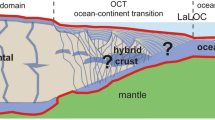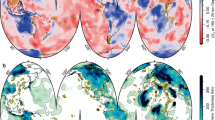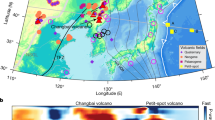Abstract
The origin of late Cenozoic intraplate volcanism over the western United States is debated. One important reason is the lack of a clear understanding of the mantle dynamics during this volcanic history. Here we reconstruct the mantle thermal states beneath North America since 20 million years ago using a hybrid inverse geodynamic model with data assimilation. The model simultaneously satisfies the past subduction kinematics, present mantle tomographic image and the volcanic history. We find that volcanism in both the Yellowstone volcanic province and the Basin and Range province corresponds to a similar eastward-intruding mantle derived from beneath the Pacific Ocean and driven mostly by the sinking Farallon slab below the central-eastern United States. The hot mantle that forms the Columbia River flood basalt and subsequent Yellowstone–Newberry hotspot tracks first enters the western United States through tears within the Juan de Fuca slab. Subsequent coexistence of the westward asthenospheric flow above the retreating Juan de Fuca slab and eastward-propagating mantle beyond the back-arc region reproduces the bifurcating hotspot chains. A similar but weaker heat source intrudes below the Basin and Range around the southern edge of the slab, and can explain the diffuse basaltic volcanism in this region. According to our models, the putative Yellowstone plume contributes little to the formation of the Yellowstone volcanic province.
This is a preview of subscription content, access via your institution
Access options
Access Nature and 54 other Nature Portfolio journals
Get Nature+, our best-value online-access subscription
$29.99 / 30 days
cancel any time
Subscribe to this journal
Receive 12 print issues and online access
$259.00 per year
only $21.58 per issue
Buy this article
- Purchase on Springer Link
- Instant access to full article PDF
Prices may be subject to local taxes which are calculated during checkout





Similar content being viewed by others
Change history
19 February 2018
In the version of this Article originally published, data points representing mafic eruptions were missing from Fig. 4b, the corrected version is shown below. Furthermore, the authors omitted to include the following acknowledgements to the provider of the computational resources: “This research is part of the Blue Waters sustained-petascale computing project, which is supported by the National Science Foundation (awards OCI-0725070 and ACI-1238993) and the state of Illinois. Blue Waters is a joint effort of the University of Illinois at Urbana-Champaign and its National Center for Supercomputing Applications. This work is also part of the ‘PRAC Title 4-D Geodynamic Modeling With Data Assimilation: Origin Of Intra-Plate Volcanism In The Pacific Northwest’ PRAC allocation support by the National Science Foundation (award number ACI 1516586). This work also used the Extreme Science and Engineering Discovery Environment (XSEDE), which is supported by National Science Foundation grant number ACI-1548562.” Figure 4 and the Acknowledgements section have been updated in the online version of the Article.
References
Pierce, K. L. & Morgan, L. A. The track of the Yellowstone hot spot: volcanism, faulting, and uplift. Geol. Soc. Am. Mem. 179, 1–54 (1992).
Camp, V. E. & Ross, M. E. Mantle dynamics and genesis of mafic magmatism in the intermontane Pacific Northwest. J. Geophys. Res. 109, B8 (2004).
Smith, R. B., Jordan, M., Steinberger, B., Puskas, C. M., Farrell, J., Waite, G. P., Husen, S., Chang, W. L. & O’Connell, R. Geodynamics of the Yellowstone hotspot and mantle plume: seismic and GPS imaging, kinematics, and mantle flow. J. Volcanol. Geoth. Res. 188, 26–56 (2009).
Kincaid, C., Druken, K. A., Griffiths, R. W. & Stegman, D. R. Bifurcation of the Yellowstone plume driven by subduction-induced mantle flow. Nat. Geosci. 6, 395–399 (2013).
Carlson, R. W. & Hart, W. K. Crustal genesis on the Oregon plateau. J. Geophys. Res. 92, 6191–6206 (1987).
Christiansen, R. L., Foulger, G. R. & Evans, J. R. Upper-mantle origin of the Yellowstone hotspot. Geol. Soc. Am. Bull. 114, 1245–1256 (2002).
James, D., Fouch, M., Carlson, R. & Roth, J. Slab fragmentation, edge flow and the origin of the Yellowstone hotspot track. Earth Planet. Sci. Lett. 311, 124–135 (2011).
Liu, L. & Stegman, D. R. Origin of the Columbia River flood basalt controlled by propagating rupture of the Farallon slab. Nature 482, 386–390 (2012).
King, S. D. & Anderson, D. L. Edge-driven convection. Earth Planet. Sci. Lett. 160, 289–296 (1998).
Hales, T. C., Abt, D. L., Humphreys, E. D. & Roering, J. J. A lithospheric instability origin for Columbia River Flood Basalts and Wallowa Mountains uplift in northeast Oregon. Nature 438, 842–845 (2005).
Seton, M., Müller, R. D., Zahirovic, S., Gaina, C., Torsvik, T., Shephard, G., Talsma, A., Gurnis, M., Turner, M. & Chandler, M. Global continental and ocean basin reconstructions since 200 Ma. Earth-Science Rev. 113, 212–270 (2012).
van der Hilst, R. D., Widiyantoro, S. & Engdahl, E. R. Evidence of deep mantle circulation from global tomography. Nature 386, 578–584 (1997).
Grand, S. P. Mantle shear-wave tomography and the fate of subducted slabs. Phil. Trans. R. Soc. Lond. A 360, 2475–2491 (2002).
Ren, Y., Stutzmann, E., van Der Hilst, R. D. & Besse, J. Understanding seismic heterogeneities in the lower mantle beneath the Americas from seismic tomography and plate tectonic history. J. Geophys. Res. 112, B004154 (2007).
Sigloch, K. Mantle provinces under North America from multifrequency P wave tomography. Geochem. Geophys. Geosyst. 12, Q02W08 (2011).
van der Meer, D. G., Spakman, W., Van Hinsbergen, D. J. J., Amaru, M. L. & Torsvik, T. H. Towards absolute plate motions constrained by lower-mantle slab remnants. Nat. Geosci. 3, 36–40 (2010).
Müller, R. D., Sdrolias, M., Gaina, C., Steinberger, B. & Heine, C. Long-term sea-level fluctuations driven by ocean basin dynamics. Science 319, 1357–1362 (2008).
Liu, L. The ups and downs of North America: evaluating the role of mantle dynamic topography since the Mesozoic. Rev. Geophys. 53, 1022–1049 (2015).
Leonard, T. & Liu, L. The role of a mantle plume in the formation of Yellowstone volcanism. Geophys. Res. Lett. 43, 1132–1139 (2016).
Schmandt, B. & Lin, F. C. P & S wave tomography of the mantle beneath the United States. Geophys. Res. Lett. 41, 6342–6349 (2014).
Liu, L. & Stegman, D. R. Segmentation of the Farallon slab. Earth Planet. Sci. Lett. 311, 1–10 (2011).
Liu, L. & Gurnis, M. Simultaneous inversion of mantle properties and initial conditions using an adjoint of mantle convection. J. Geophys. Res. 113, B08405 (2008).
Zhou, Q. & Liu, L. A hybrid approach to data assimilation for reconstructing the evolution of mantle dynamics. Geochem. Geophys. Geosyst. 18, C007116 (2017).
Schmandt, B., Dueker, K. G., Humphreys, E. D. & Hansen, S. H. Hot mantle upwelling across the 660 beneath Yellowstone. Earth Planet. Sci. Lett. 331–332, 224–236 (2012).
Gao, S. S. & Liu, K. H. Mantle transition zone discontinuities beneath the contiguous United States. J. Geophys. Res. 119, 6452–6468 (2015).
Leeman, W. P., Schutt, D. L. & Hughes, S. S. Thermal structure beneath the Snake River Plain: implications for the Yellowstone hotspot. J. Volcanol. Geoth. Res. 188, 57–67 (2009).
Ritsema, J., Deuss, A., van Heijst, H. J. & Woodhouse, J. H. S40RTS: a degree-40 shear-velocity model for the mantle from new Rayleigh wave dispersion, teleseismic traveltime and normal-mode splitting function measurements. Geophys. J. Int. 184, 1223–1236 (2011).
Hier-Majumder, S. & Tauzin, B. Pervasive upper mantle melting beneath the western US. Earth Planet. Sci. Lett. 463, 25–35 (2017).
Bozdağ, E., Peter, D., Lefebvre, M., Komatitsch, D., Tromp, J., Hill, J., Podhorszki, N. & Pugmire, D. Global adjoint tomography: first-generation model. Geophys. J. Int. 207, 1739–1766 (2106).
Huang, Z. & Zhao, D. Mapping P-wave azimuthal anisotropy in the crust and upper mantle beneath the United States. Phys. Earth Planet. Int. 225, 28–40 (2013).
McQuarrie, N. & Wernicke, B. P. An animated tectonic reconstruction of southwestern North America since 36 Ma. Geosphere 1, 147–172 (2005).
Humphreys, E. D. Post-Laramide removal of the Farallon slab, western United States. Geology 23, 987–990 (1995).
DePaolo, D. J. & Daley, E. E. Neodymium isotopes in basalts of the southwest basin and range and lithospheric thinning during continental extension. Chem. Geol. 169, 157–185 (2000).
Gans, P. B. & Bohrson, W. A. Suppression of volcanism during rapid extension in the Basin and Range Province, United States. Science 279, 66–68 (1998).
Roy, M., Jordan, T. H. & Pederson, J. Colorado Plateau magmatism and uplift by warming of heterogeneous lithosphere. Nature 459, 978–982 (2009).
Reid, M. R., Bouchet, R. A., Blichert-Toft, J., Levander, A., Liu, K., Miller, M. S. & Ramos, F. C. Melting under the Colorado Plateau, USA. Geology 40, 387–390 (2012).
Katz, R. F., Spiegelman, M. & Langmuir, C. H. A new parameterization of hydrous mantle melting. Geochem. Geophys. Geosyst. 4, 1073 (2003).
McCurry, M. & Rodgers, D. W. Mass transfer along the Yellowstone hotspot track I: petrologic constraints on the volume of mantle-derived magma. J. Volcanol. Geotherm. Res. 188, 86–98 (2009).
Carlson, R. W., Pearson, D. G. & James, D. E. Physical, chemical, and chronological characteristics of continental mantle. Rev. Geophys. 43, RG1001 (2005).
Griffin, W. L., O’Reilly, S. Y., Doyle, B. J., Pearson, N. J., Coopersmith, H., Kivi, K. & Pokhilenko, N. Lithosphere mapping beneath the North American plate. Lithosphere 77, 873–922 (2004).
Mareschal, J. C. & Jaupart, C. Variations of surface heat flow and lithospheric thermal structure beneath the North American craton. Earth Planet. Sci. Lett. 223, 65–77 (2004).
Hansen, S. M., Dueker, K. & Schmandt, B. Thermal classification of lithospheric discontinuities beneath USArray. Earth Planet. Sci. Lett. 431, 36–47 (2015).
Humphreys, E. D., Schmandt, B., Bezada, M. J. & Perry-Houts, J. Recent craton growth by slab stacking beneath Wyoming. Earth Planet. Sci. Lett. 429, 170–180 (2015).
Gerya, T. V., Yuen, D. A. & Sevre, E. O. D. Dynamic causes for incipient magma chambers above slabs. Geology 32, 89–92 (2004).
Rodgers, D.W., Ore, H. T., Bobo, R. T., McQuarrie, N. & Zentner, N. in Tectonic and Magmatic Evolution of the Snake River Plain Volcanic Province (eds Bonnichsen, B., White, C. M. & McCurry, M.) 121–155 (Bulletin 30, Idaho Geological Survey, Moscow, 2002).
Ballmer, M. D., Conrad, C. P., Smith, E. I. & Johnsen, R. Intraplate volcanism at the edges of the Colorado Plateau sustained by a combination of triggered edge‐driven convection and shear‐driven upwelling. Geochem. Geophys. Geosyst. 16, 366–379 (2015).
Darold, A. & Humphreys, E. D. Upper mantle seismic structure beneath the Pacific Northwest: A plume-triggered delamination origin for the Columbia River flood basalt eruptions. Earth Planet. Sci. Lett. 365, 232–242 (2013).
Huang, H. H., Lin, F. C., Schmandt, B., Farrell, J., Smith, R. B. & Tsai, V. C. The Yellowstone magmatic system from the mantle plume to the upper crust. Science 348, 773–776 (2015).
Asahara, Y. & Ohtani, E. Melting relations of the hydrous primitive mantle in the CMAS–H2O system at high pressures and temperatures, and implications for generation of komatiites. Phys. Earth Planet. Inter. 125, 31–44 (2011).
Green, D. H. Experimental petrology of peridotites, including effects of water and carbon on melting in the Earth’s upper mantle. Phys. Chem. Minerals 42, 95–122 (2015).
Green, D. H. & O’Hara, M. J. Composition of basaltic magmas as indicators of conditions of origin: application to oceanic volcanism. Phil. Trans. R. Soc. A 268, 707–725 (1971).
Acknowledgements
The numerical models were performed using CitcomS (www.geodynamics.org) and GPlates (www.gplates.org). Figures were prepared using the GMT software package (https://www.soest.hawaii.edu/gmt/). This work is supported by National Science Foundation grant EAR-1345135, EAR-1554554. This research is part of the Blue Waters sustained-petascale computing project, which is supported by the National Science Foundation (awards OCI-0725070 and ACI-1238993) and the state of Illinois. Blue Waters is a joint effort of the University of Illinois at Urbana-Champaign and its National Center for Supercomputing Applications. This work is also part of the “PRAC Title 4-D Geodynamic Modeling With Data Assimilation: Origin Of Intra-Plate Volcanism In The Pacific Northwest” PRAC allocation support by the National Science Foundation (award number ACI 1516586). This work also used the Extreme Science and Engineering Discovery Environment (XSEDE), which is supported by National Science Foundation grant number ACI-1548562.
Author information
Authors and Affiliations
Contributions
Q.Z. carried out all the numerical simulations. L.L. designed and oversaw the project. Both Q.Z. and L.L. contributed to the results interpretation and manuscript preparation. J.H. contributed to the figure preparation.
Corresponding author
Ethics declarations
Competing financial interests
The authors declare no competing financial interests.
Additional information
Publisher’s note: Springer Nature remains neutral with regard to jurisdictional claims in published maps and institutional affiliations.
A correction to this article is available online at https://doi.org/10.1038/s41561-018-0062-3.
Supplementary information
Supplementary Information
Supplementary description and figures.
Videos
Supplementary Movie 1
Mantle flow for model A4.
Supplementary Movie 2
Mantle flow for model A5.
Supplementary Movie 3
Mantle flow for model A6.
Supplementary Movie 4
Mantle flow for model A7.
Rights and permissions
About this article
Cite this article
Zhou, Q., Liu, L. & Hu, J. Western US volcanism due to intruding oceanic mantle driven by ancient Farallon slabs. Nature Geosci 11, 70–76 (2018). https://doi.org/10.1038/s41561-017-0035-y
Received:
Accepted:
Published:
Issue Date:
DOI: https://doi.org/10.1038/s41561-017-0035-y
This article is cited by
-
Cenozoic eastward growth of the Tibetan Plateau controlled by tearing of the Indian slab
Nature Geoscience (2024)
-
Origin and tectonic setting of low-Si alkaline magma
Science China Earth Sciences (2024)
-
Mechanisms to generate ultrahigh-temperature metamorphism
Nature Reviews Earth & Environment (2023)
-
Progress in the numerical modeling of mantle plumes
Science China Earth Sciences (2023)
-
Hyperextended crustal structure of the Qiongdongnan Basin and subsequent magmatic influence from the Hainan mantle plume
Science China Earth Sciences (2022)



